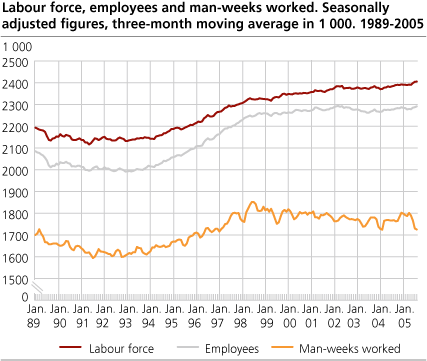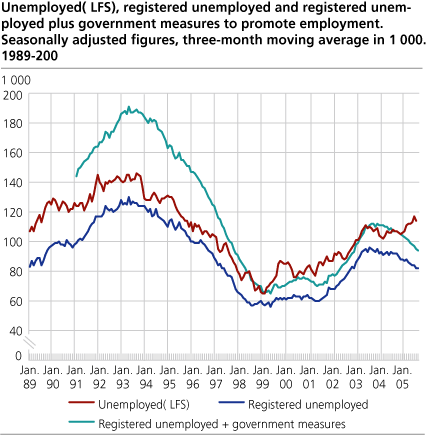Content
Published:
This is an archived release.
More people working full time
The number of employees with a settled working hour of 37 hours or more per week increased by 19 000 from Q3 2004 to Q3 2005, while the number of underemployed went down. The figures are taken from the latest Labour Force Survey (LFS) carried out by Statistics Norway.
|
Seasonally adjusted figures: More people employed
Unemployment stayed approximately unchanged from the second to the third quarter of 2005, while the number of employees rose, according to seasonally adjusted figures from the LFS. The increase in employment was inside the LFS error margin, but is consistent with the upward trend we have seen since the summer of 2003. The seasonal adjustment method is a favourable method of revealing the current development in the labour market, and serves as an alternative to comparisons with the corresponding quarter in the previous year. Seasonally adjusted figures are presented in a separate article. |
Both men and women experienced an increase in full time employment. The increase in total employment was not large when compared with the development of the population figure. The proportion of the population aged 16-74 employed, i.e. the employment ratio, went down from 69.8 per cent in the third quarter of 2004 to 69.6 per cent in the third quarter of 2005.
High level of holiday absence
The average number of people with absence from work for a whole week due to holidays increased from 419 000 in the third quarter of 2004 to 465 000 in the third quarter of 2005. This development is partly related to the fact that the first reference week was one week later in the summer, and partly due to an increase in the number of people taking holiday leave, when comparing the third quarter of 2005 with the same quarter of 2004. The growth in holiday absence in the third quarter partly corresponds to a lower level of holiday absence in the second quarter of 2005 than in 2004, i.e. 66 000 people this year against 97 000 last year. The change in the seasonal vacation pattern creates problems particularly when assessing the development in man-weeks worked. Health and social work had an increase in employment of 19 000 people from the third quarter of 2004 to the third quarter of 2005. This is a typical industry division where much of the holiday absence must be compensated with substitutes or with an increase in the working time of the employees at work. The LFS figures show an increase of 11 000 in the number of employees with temporary jobs in this particular industry division. Employment in financial intermediation and business activities rose by 13 000 people, of which the number with temporary jobs went up by 4 000.
Fewer people underemployed
The number of underemployed, i.e. part-time employees who want to work more hours, fell from 98 000 to 90 000 from the third quarter of 2004 to the third quarter of 2005, and women accounted for all of the decline. The development in underemployment can be seen in connection with the increase in full time employment. In addition, the health and social work industry contributed to most of the decline.
The underemployed represent 15.3 per cent of all part-time employees, compared with 16.7 per cent in the third quarter of 2004. The majority of the underemployed work in health and social work or retail trade. Half of all part-time employees work in these two sectors.
117 000 people unemployed
The number of unemployed people in the third quarter of 2005 was 117 000, an increase of 7 000 from the third quarter of 2004. The total unemployment rate was 4.8 per cent, the rate for men 5.0 per cent and the rate for women 4.7 per cent. The total figure for the third quarter of 2004 was 4.6 per cent.
The proportion of long-term unemployed fell from 26 to 23 per cent the last one-year period. Long-term unemployment is defined as unemployment that has lasted for at least six consecutive months.
Actual hours worked for the unemployed and underemployed amounted to 132 000 man-weeks (full-time work) in the third quarter of 2005 - 5 000 more than in the third quarter 2004.
Fall in unemployment internationally
The seasonally adjusted unemployment rate for Norway was 4.8 per cent in August 2005, up from 4.7 per cent in May. The rate in the EU area stayed unchanged at 7.9 per cent, while the OECD area saw a fall from 6.6 to 6.5 per cent. In the same period, the unemployment rate fell from 5.1 to 4.9 per cent in the USA, from 5.0 to 4.8 per cent in Denmark, and from 8.3 to 8.2 per cent in Finland. From May to August, the unemployment rate fell from 9.8 to 9.6 per cent in France, while Germany recorded an increase from 9.5 to 9.6 per cent, according to figures from the OECD and Eurostat .
Tables:
- Table 1. Population aged 16-74 in the labour force, man-weeks worked, registered unemployed persons and persons employed by government measures. 1000 and per cent
- Table 2. Population aged 16-74 år in the labour force, employed persons and unemployed persons by sex (LFS). 1000 and per cent
- Table 3 Persons in the labour force and employed persons by age and sex (LFS). 1 000 and per cent.
- Table 4. Population aged 16-74, employed persons by settled/usual working hours per week(1) and unemployed persons by age and sex (LFS). 1000
- Table 5. Persons in the labour force by age and sex. 1000 and as per cent of all in each group
- Table 6 Employed persons by sex and settled/usual working hours pr week (LFS). 1 000
- Table 7 Population aged 16-74 by main activity, part-time employment1 and age (LFS). 1 000
- Table 8. Employed persons by major industry division. 1000
- Table 9 Number of man-hours worked per week1, by industry division (LFS). 1 000
- Table 10 Employed persons,total, and employed persons at work by status and sex. Number of man-weeks worked1 and actual working hours per week (LFS)
- Table 11. Employed persons and absence from work during the whole survey week by reason for absence and sex(1). 1000 and per cent
- Table 12. Employees with temporary jobs, by major industry division (LFS). 1000 and as per cent of all employees
- Table 13. Unemployed persons by sex and age (LFS). 1000 and per cent
- Table 14. Unemployed persons by duration of job search (LFS). 1000 and per cent
- Table 15 Unemployed persons by main activity (LFS). 1 000
- Table 16. Unemployed and underemployed persons, by sex and desired working hours per week. Number of man-weeks (of 37,5 hours) supplied (LFS). 1000
- Table 17. Employment and unemployment for persons aged 16-74 years, seasonally adjusted, three-months moving average. Absolute figures in 1000 and unemployed persons in per cent of the labour force.
- Table 18 Persons in the labour force by sex and region (LFS). 1 000 and in per cent of total
- Table 19 Employed persons by sex and region (LFS). 1 000
- Table 20 Employed persons by sex and regions (LFS) as per cent of all inn each group
- Table 21 Employed persons, by some major industry division and region (LFS). 1997-2004. 1 000
Contact
-
Arbeidsmarked og lønn
E-mail: arbeidsmarked@ssb.no
-
Erik Herstad Horgen
E-mail: erik.horgen@ssb.no
tel.: (+47) 93 08 68 62
-
Håvard Hungnes Lien
E-mail: havard.lien@ssb.no
tel.: (+47) 40 90 26 06


